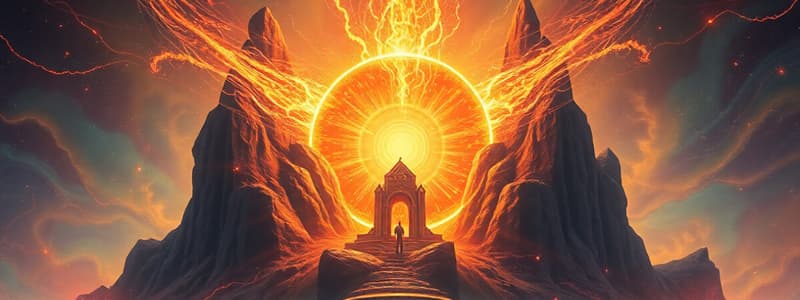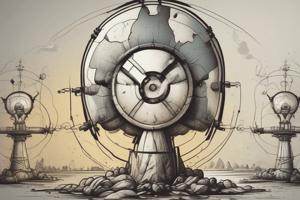Podcast
Questions and Answers
The proton is the nucleus of the oxygen atom.
The proton is the nucleus of the oxygen atom.
False (B)
Nuclear reactions with protons vary based on the kinetic energy of the projectile.
Nuclear reactions with protons vary based on the kinetic energy of the projectile.
True (A)
Protons are irrelevant in nuclear reactions.
Protons are irrelevant in nuclear reactions.
False (B)
A higher kinetic energy of a proton leads to different nuclear reaction outcomes.
A higher kinetic energy of a proton leads to different nuclear reaction outcomes.
The nuclear reactions involving protons are always the same, regardless of conditions.
The nuclear reactions involving protons are always the same, regardless of conditions.
The Q-value for exothermal reactions is negative.
The Q-value for exothermal reactions is negative.
Endothermal reactions have a positive Q-value.
Endothermal reactions have a positive Q-value.
The Q-value of the reaction is 22.2 MeV.
The Q-value of the reaction is 22.2 MeV.
In chemistry, the expression for reaction energy is consistent with that of nuclear reactions.
In chemistry, the expression for reaction energy is consistent with that of nuclear reactions.
Exothermal reactions compare to endothermal reactions with opposite Q-value signs.
Exothermal reactions compare to endothermal reactions with opposite Q-value signs.
Flashcards
Exothermal Reaction Q-value
Exothermal Reaction Q-value
A positive Q-value indicates an exothermic nuclear reaction, releasing energy.
Endothermal Reaction Q-value
Endothermal Reaction Q-value
A negative Q-value indicates an endothermic nuclear reaction, absorbing energy.
Q-value Units
Q-value Units
The Q-value is measured in MeV (Mega-electron volts).
Nuclear Reaction Energy
Nuclear Reaction Energy
Signup and view all the flashcards
Exothermic vs. Endothermic
Exothermic vs. Endothermic
Signup and view all the flashcards
Nuclear reactions with protons
Nuclear reactions with protons
Signup and view all the flashcards
Proton projectile's energy
Proton projectile's energy
Signup and view all the flashcards
Hydrogen atom's nucleus
Hydrogen atom's nucleus
Signup and view all the flashcards
Nuclear reactions
Nuclear reactions
Signup and view all the flashcards
Kinetic energy of a projectile
Kinetic energy of a projectile
Signup and view all the flashcards
Study Notes
Nuclear Reactions
- A nuclear reaction is the process where two nuclei or a nucleus and a subatomic particle collide, producing one or more new nuclides.
- This transformation, at a minimum, changes one nuclide to another.
- If the nuclei/particles interact and separate without changing the nuclides, the process is nuclear scattering, not a reaction.
Q-value and Energy Balance
- Reaction energy ("Q-value") is the difference between the sums of kinetic energies on the final side and initial side; also the difference between nuclear rest masses on the initial and final sides.
- Positive values indicate exothermic reactions (release energy).
- Negative values indicate endothermic reactions (absorb energy).
Balancing Nuclear Reactions
- Balanced nuclear equations conserve mass numbers and charges.
- The sum of the mass numbers of reactants equals the sum of the mass numbers of products.
- The sum of the charges of reactants equals the sum of the charges of products.
Types of Nuclear Reactions
- Nuclear reactions vary based on the nature of the projectile (neutron, proton, deuteron, alpha particle).
- Neutron-Gamma (n, γ); This reaction occurs at low neutron speed. The result is an isotope of the interacting element, typically with the neutron absorbed.
- Neutron-Proton (n, p); The proton in this reaction binds with electrons surrounding the nucleus, effectively turning into a hydrogen atom.
- Neutron-Alpha (n, α); High neutron speed is necessary for this reaction. An alpha particle is released.
- Neutron-Neutron (n, n); Typically involves a neutron with an energy between 100 keV and a few MeV striking another neutron, leaving the second neutron unchanged.
- Neutron-2Neutron (n, 2n); This reaction requires high-energy neutrons. The result is an isotope of the interacting nucleus with atomic weight reduced by one.
- Proton-Alpha (p, α); The result is a unique nucleus and an alpha particle.
- Proton-Neutron (p, n); An exothermic reaction resulting in an isotope of the interacting nucleus.
- Proton-Gamma (p, γ); Gamma rays are produced.
- Proton-Deuteron (p, d); Results in an isotope of the interacting nucleus.
- Deuteron-Alpha (d, α): Exothermic reaction. The result is an isotope of the interacting nucleus and an alpha particle.
- Deuteron-Proton (d, p); Exothermic reaction with an isotope of the nucleus.
- Deuteron-Neutron (d, n); This involves deuterons and results in an isotope of the interacting nucleus or a unique nucleus plus a neutron.
- Alpha-Neutron (α, n); Results in a neutron and an isotope of the interacting nucleus or an element altogether unique.
- Alpha-Proton (α, p); Results in a proton and an isotope of the interacting nucleus or an element altogether unique.
Nuclear Fission
- Fission is the splitting of a heavy nucleus (A > 200) into two or more smaller nuclei.
- Fission typically releases free neutrons, gamma rays, beta particles and other nuclear fragments.
- Fission is exothermic, releasing significant energy, both as gamma rays and kinetic energy.
- Induced fission occurs from neutron bombardment. Fission fragments are highly unstable due to excess neutrons. Fast neutrons are emitted during fission and undergo beta decay, producing more energy.
- The energy produced in fission equals around 200 MeV, a significant amount, considerably more than burning coal, oil, or gas.
- The critical mass is the minimum mass required to sustain a chain reaction.
- Fission is used in power plants and nuclear weapons.
Nuclear Fusion
- Fusion is the process of combining two lighter nuclei to create a single heavier nucleus.
- Fusion releases a vast amount of energy.
- Hydrogen atoms are commonly fused to create helium.
- Fusion reactions require high temperatures and pressures.
- Fusion is the process powering stars and is desirable for energy generation. The enormous amount of energy released from fusion is far greater than in fission for the same mass, and in terms of more convenient fuels for fusion reactions.
Thermonuclear Reactions
- High-temperature reactions combining nuclei.
- In stars, primarily proton-proton and carbon cycles for energy output.
- In the lab, fusion of hydrogren isotopes (deuterium, tritium).
Types of Reactors
- Power reactors produce electricity via nuclear fission reactions.
- Research reactors produce high neutron fluxes for experiments.
- Heat production reactors supply heat in certain colder climates.
- Radioisotope reactors create radioactive elements.
- Training reactors are present to train personnel.
- Some reactors are designed for weapons development. Certain reactors may also assist in saltwater desalination.
Nuclear Reactor Problems
- Serious accidents releasing radioactive materials are a concern.
- Thermal pollution from cooling systems affects the environment.
- Radioactive waste disposal poses a significant problem; it's half-life could be thousands of years.
- Accidents at nuclear reactors are well documented and publicized.
- To implement nuclear power successfully, lower costs, improved safety, better waste management, and lower proliferation risks are essential.
Energy Released
- Energy released during mass destruction is calculable with Einstein's equation (E=mc²).
- Energy released in fission and fusion reactions is calculable, in electron volts/atom and kilojoules/mol.
Studying That Suits You
Use AI to generate personalized quizzes and flashcards to suit your learning preferences.




